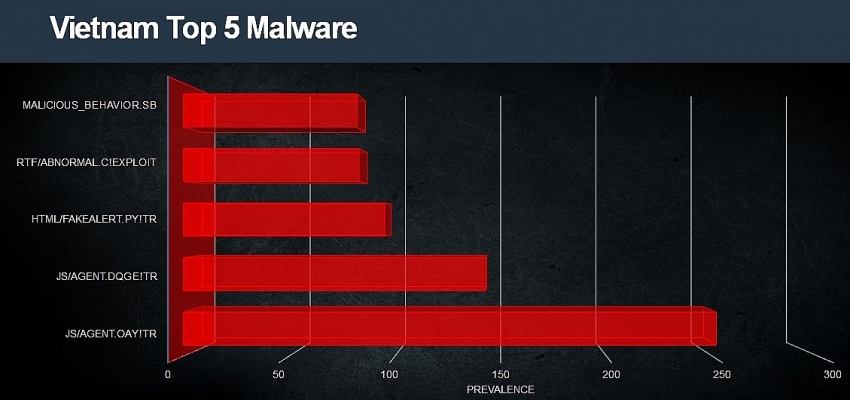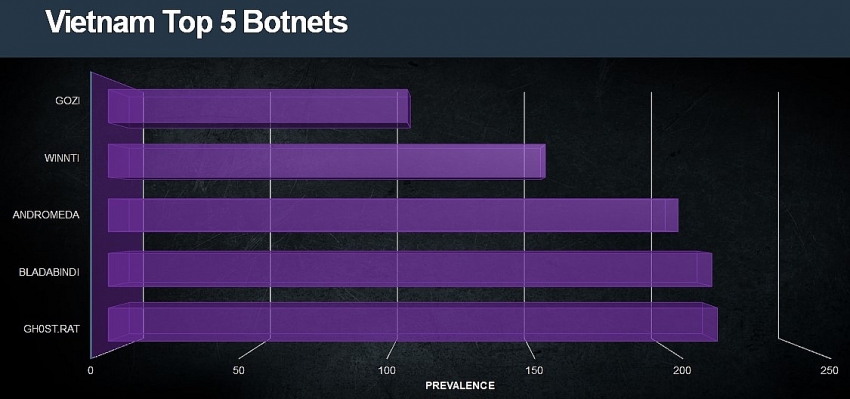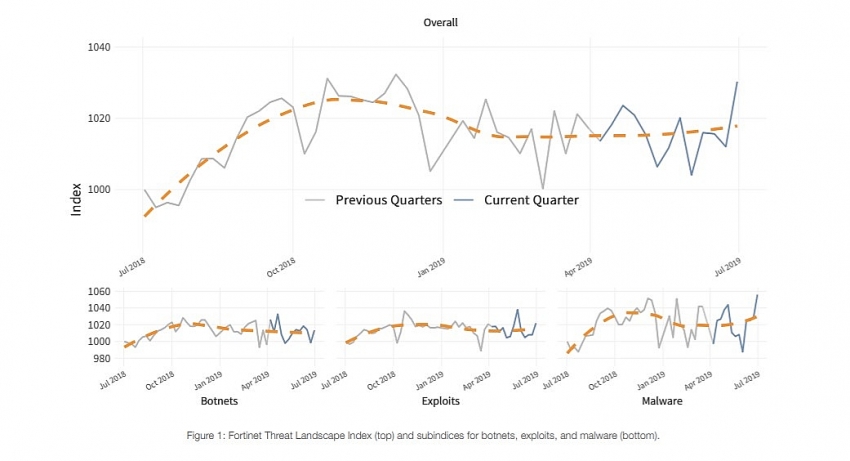Fortinet threat landscape index hits historic record
 |
| Fortinet threat landscape index hit its highest point to date, demonstrating continued increases in cyberattacks |
The research reveals that cybercriminals continue to look for new attack opportunities throughout the digital attack surface and are leveraging evasion as well as anti-analysis techniques as they become more sophisticated in their attempts.
The Threat Landscape Index crossed a milestone this quarter. It is up nearly 4 per cent from its original opening position year-over-year. The high point during that year-long timeframe is the peak and closing point of the second quarter of the 2019 calendar year. The upsurge was driven by increased malware and exploit activity.
For a detailed view of the Threat Landscape Index and subindices for exploits, malware, and botnets, as well as some important takeaways for CISOs, read the blog. Highlights of the report are as follows"
Upping the ante on evasion tactics
Many modern malware tools already incorporate features for evading antivirus or other threat detection measures, but cyber adversaries are becoming more sophisticated in their obfuscation and anti-analysis practices to avoid detection.
For example, a spam campaign demonstrates how adversaries are using and tweaking these techniques against defenders. The campaign involves the use of a phishing email with an attachment that turned out to be a weaponised Excel document with a malicious macro. The macro has attributes designed to disable security tools, execute commands arbitrarily, cause memory problems, and ensure that it only runs on Japanese systems. One property that it looks for in particular, an xlDate variable, seems to be undocumented.
Another example involves a variant of the Dridex banking trojan which changes the names and hashes of files each time the victim logs in, making it difficult to spot the malware on infected host systems.
The growing use of anti-analysis and broader evasion tactics is a reminder of the need for multi-layered defences and behaviour-based threat detection.
Under-the-radar attacks aim for the long-haul
The Zegost infostealer malware is the cornerstone of a spear phishing campaign and contains intriguing techniques. Like other infostealers, the main objective of Zegost is to gather information about the victim’s device and exfiltrate it. Compared to other infostealers, Zegost is uniquely configured to stay under the radar. For example, Zegost includes functionality designed to clear the application, security, and system event logs. This type of cleanup is not seen in typical malware. Another interesting development in Zegost’s evasion capabilities is a command that kept the infostealer “in stasis” until after February 14, 2019, after which it began its infection routine.
The threat actors behind Zegost utilise an arsenal of exploits to ensure they establish and maintain a connection to targeted victims, making it far more of a long-term threat compared to its contemporaries.
 |
Ransomware continues to trend to more targeted attacks
The attacks on multiple cities, local governments, and education systems serve as a reminder that ransomware is not going away but instead continues to pose a serious threat for many organisations going forward. Ransomware attacks continue to move away from mass-volume, opportunistic attacks to more targeted attacks on organisations, which are perceived as having either the ability or the incentive to pay ransom. In some instances, cybercriminals have conducted considerable reconnaissance before deploying their ransomware on carefully selected systems to maximise opportunity.
For example, the RobbinHood ransomware is designed to attack an organisation's network infrastructure and is capable of disabling Windows services that prevent data encryption and to disconnect from shared drives.
Another newer ransomware called Sodinokibi could become another threat for organisations. Functionally, it is not very different from the majority of ransomware tools in the wild. It is troublesome because of the attack vector, which exploits a newer vulnerability that allows for arbitrary code execution and does not need any user interaction like other ransomware being delivered by phishing email.
Regardless of the vector, ransomware continues to pose a serious threat for organisations going forward, serving as a reminder of the importance of prioritising patching and infosecurity awareness education. In addition, Remote Desktop Protocol (RDP) vulnerabilities, such as BlueKeep are a warning that remote access services can be opportunities for cybercriminals and that they can also be used as an attack vector to spread ransomware.
 |
New opportunities in the digital attack surface
Between the home printer and critical infrastructure is a growing line of control systems for residential and small business use. These smart systems garner comparably less attention from attackers than their industrial counterparts, but that may be changing based on increased activity observed targeting these control devices such as environmental controls, security cameras, and safety systems. A signature related to building management solutions was found to be triggered in 1 per cent of organisations, which may not seem like much, but it is higher than typically seen for ICS or SCADA products.
Cybercriminals are searching for new opportunities to commandeer control devices in homes and businesses. Sometimes these types of devices are not as prioritised as others or are outside the scope of traditional IT management. The security of smart residential and small business systems deserves elevated attention especially since access could have serious safety ramifications. This is especially relevant for remote work environments where secure access is important.
How to protect your organisation: broad, integrated, and automated security
Threat intelligence that is dynamic, proactive, and available in real-time can help identify trends showing the evolution of attack methods targeting the digital attack surface and to pinpoint cyber hygiene priorities. The value and ability to take action on threat intelligence is severely diminished if it cannot be actionable in real-time across each security device. Only a security fabric that is broad, integrated, and automated can provide protection for the entire networked environment, from IoT to the edge, network core, and to multi-clouds at speed and scale.
Report and index overview
The latest Fortinet threat landscape report is a quarterly view that represents the collective intelligence of FortiGuard Labs, drawn from Fortinet’s vast array of global sensors during the second quarter of 2019. Research data covers global and regional perspectives. Also included in the report is the Fortinet Threat Landscape Index, comprised of individual indices for three central and complementary aspects of that landscape which are exploits, malware, and botnets, showing prevalence and volume in a given quarter.
Phil Quade, chief information security officer, Fortinet, said, “The ever-widening breadth and sophistication of cyber adversaries’ attack methods is an important reminder of how they are attempting to leverage speed and connectivity to their advantage. Therefore, it is important for defenders to do the same and to relentlessly prioritise these important cybersecurity fundamentals, to position organisations to better manage and mitigate cyber risks. A security fabric approach across every security element that embraces segmentation and integration, actionable threat intelligence, and automation combined with machine learning is essential to enable these fundamentals to bear fruit.”
What the stars mean:
★ Poor ★ ★ Promising ★★★ Good ★★★★ Very good ★★★★★ Exceptional
Related Contents
Latest News
More News
- Businesses ramp up production as year-end orders surge (December 30, 2025 | 10:05)
- Vietjet chairwoman awarded Labour Hero title (December 29, 2025 | 13:06)
- How to unlock ESG value through green innovation (December 29, 2025 | 10:03)
- AI reshapes media and advertising industry (December 29, 2025 | 08:33)
- FPT and GELEX sign deal to develop blockchain tech for global markets (December 29, 2025 | 08:29)
- Vietnam’s GDP forecast to grow by 9 per cent in 2026 (December 29, 2025 | 08:29)
- Women entrepreneurs are key to Vietnam’s economic growth (December 29, 2025 | 08:00)
- Vietnam's top 500 value-creating enterprises announced (December 27, 2025 | 08:00)
- The PAN Group shaping a better future with ESG strategy (December 26, 2025 | 09:00)
- Masan Consumer officially lists on HSX, marking the next phase of value creation (December 25, 2025 | 13:20)

 Tag:
Tag:


























 Mobile Version
Mobile Version